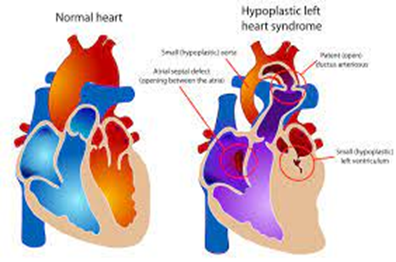Nick was diagnosed with Hypoplastic Left Heart Syndrome. Which of the following responses should the nurse educate his parents regarding the treatment of this disease?
Surgery is a palliative measure. The patient will require a heart transplant
The surgeon will create an opening between the atria and ventricles to allow oxygenated blood flow to the body. He should be cured with this simple surgery
This problem is caused by the displacement of the pulmonary artery and aortic artery. Surgery will be performed to put these arteries back in place.
His condition will improve greatly after we give him prostaglandin.
The Correct Answer is A
Hypoplastic Left Heart Syndrome is a complex congenital heart defect in which the left side of the heart (left ventricle and aorta) is underdeveloped, making it unable to pump oxygenated blood effectively to the body. The treatment of HLHS typically involves a series of surgical interventions because it cannot be cured with a single surgery. The ultimate goal of treatment is to provide palliative care, which means managing the condition to improve the child's quality of life while waiting for a heart transplant. The surgical procedures are typically performed in stages, with the first surgery usually performed shortly after birth, followed by additional surgeries as the child grows.
Option B is not accurate because HLHS cannot be cured with a single surgery, and creating an opening between the atria and ventricles (e.g., the Norwood procedure) is one step in the staged surgical treatment, but it doesn't completely "cure" the condition.
Option C is not accurate because HLHS is primarily characterized by an underdeveloped left ventricle and aorta, not the displacement of the pulmonary and aortic arteries.
Option D refers to the use of prostaglandin to maintain a patent ductus arteriosus (PDA) and improve blood flow to the lungs, which can be part of the initial management of HLHS but is not a definitive treatment. Prostaglandin is used to stabilize the infant before surgical interventions are performed.

Nursing Test Bank
Naxlex Comprehensive Predictor Exams
Related Questions
Correct Answer is A
Explanation
Force fluids appropriate in age: It's important to ensure that the child receives an appropriate amount of fluids, taking into consideration their age and weight. This helps prevent dehydration and maintain adequate circulation.
In addition to option A, other important nursing care measures for infants and children with congestive heart failure include:
B. Organize activities to allow for uninterrupted sleep: Infants and children with heart failure may become fatigued easily, so it's important to create an environment that allows for sufficient rest and sleep.
C. Monitor respirations during active periods: Monitoring the child's respiratory rate and effort during active periods helps assess for signs of respiratory distress, which can be a manifestation of congestive heart failure.
D. Give smaller, more frequent feedings to conserve energy: Smaller, more frequent feedings can help reduce the energy expenditure required for digestion, making it easier for the child to eat and conserve energy for growth and development.
The focus of nursing care is to manage the symptoms of heart failure, support the child's overall well-being, and prevent complications. The specific interventions may vary based on the child's age, the severity of heart failure, and the underlying cause.
Correct Answer is ["A","C"]
Explanation
For a family with a child diagnosed with obesity and hyperlipidemia, the recommended actions in the educational pamphlet should focus on promoting a healthy lifestyle and managing these conditions effectively. The most appropriate recommendations are:
A. Children-specific heart-healthy diet: Emphasize the importance of a balanced and heart-healthy diet for the child. Include information on portion control, reducing high-fat and high-sugar foods, increasing fruit and vegetable intake, and incorporating whole grains. Encourage families to work with a registered dietitian or nutritionist for personalized dietary guidance.
C. Nutrition guidance from a pediatric specialist: Recommend seeking guidance from a pediatrician or pediatric specialist with expertise in nutrition to develop a personalized nutrition plan for the child. Individualized guidance can help address specific dietary needs and concerns related to obesity and hyperlipidemia.
In contrast, the following options should not be included:
B. Start on statin medication first: Statin medications are typically not the first-line treatment for children with hyperlipidemia, especially if lifestyle modifications can effectively manage the condition. Medication use in children is typically reserved for cases where lifestyle changes alone are insufficient or when there are other medical considerations.
D. Encourage more than 4 hours of screen time per day: Encouraging excessive screen time is not recommended, as it can contribute to a sedentary lifestyle, which is often associated with obesity. Limiting screen time and promoting physical activity are important components of managing obesity.
E. Exercise for at least 3 hours daily: While physical activity is important for managing obesity, recommending over 3 hours of exercise daily may not be realistic or sustainable for most children. Instead, it's better to encourage regular physical activity, such as at least 60 minutes of moderate to vigorous activity daily, as recommended by guidelines for children.
Overall, the focus should be on adopting a healthy lifestyle, including a balanced diet and appropriate physical activity, under the guidance of healthcare professionals, to manage obesity and hyperlipidemia in children.
Whether you are a student looking to ace your exams or a practicing nurse seeking to enhance your expertise , our nursing education contents will empower you with the confidence and competence to make a difference in the lives of patients and become a respected leader in the healthcare field.
Visit Naxlex, invest in your future and unlock endless possibilities with our unparalleled nursing education contents today
Report Wrong Answer on the Current Question
Do you disagree with the answer? If yes, what is your expected answer? Explain.
Kindly be descriptive with the issue you are facing.
